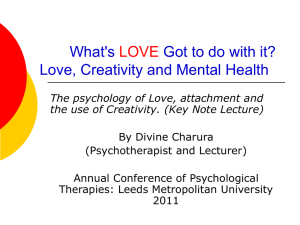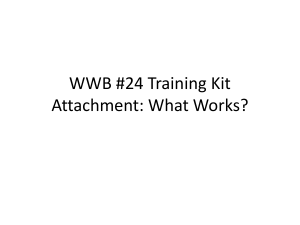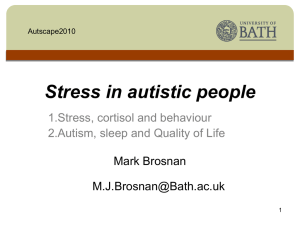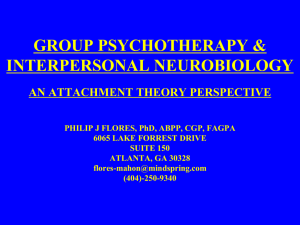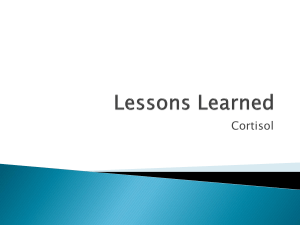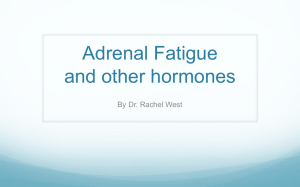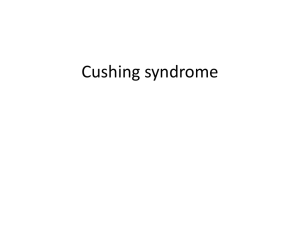Neuroendocrine correlates of insecure attachment in
advertisement
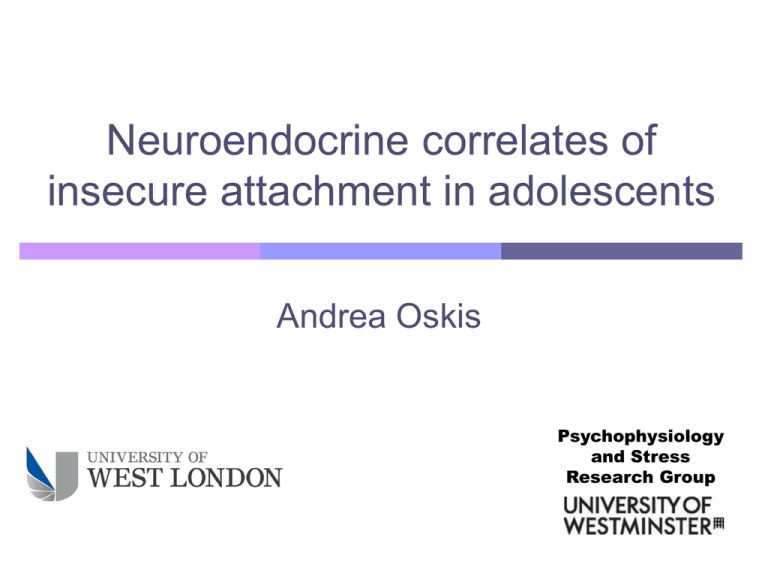
Neuroendocrine correlates of insecure attachment in adolescents Andrea Oskis Psychophysiology and Stress Research Group Attachment theory as a stress theory Bowlby’s original theory: a biobehavioural safetyregulating system Activated in times of threat or stress Internal working model STRESS! Activates our body’s ‘stress hormone hotline’ The Hypothalamic-PituitaryAdrenal (HPA) axis Secretes the hormone cortisol Cortisol is not just a stress hormone... Bone formation and resorption Maintain muscle function; decrease muscle mass Decrease connective tissue Cortisol Inhibit inflammatory and immune responses Support glucose synthesis Increase glomerular filtration and free water clearance Maintain cardiac output Modulate emotional tone, wakefulness Based on Genuth (2008) An excellent way to measure cortisol The diurnal cortisol rhythm Cortisol Awakening Response (CAR) 30 Cortisol (nmol/l) 25 20 15 10 5 0 wake-up 0 3 6 9 12 Hours post-awakening Oskis et al. (2009) Cortisol rhythms matter... Especially post-awakening Quirin et al. (2008) ... In women with early life attachment adversity ... and also with anxious insecure attachment style Meinlschmidt and Heim (2005) ...especially in adolescence... ...especially immediately post-awakening Kudielka & Kirschbaum (2003) Shirtcliff and Essex (2008) General methods Participants: 60 healthy female adolescents aged 9-18 yrs, mean age 14.16 (± 2.63) years Key measures: • Attachment Style Interview (ASI) • Saliva samples +0 mins +15 mins +30 mins +45 mins +3 hrs +6 hrs +9 hrs +12 hrs x 2 consecutive weekdays The importance of adherence • Personalised text message prompts for each saliva sample sent over the day Morning Andrea! Woke up 0702, sample 1 done @ 0702. All going well! Participant 35C, 28/02/07, age 17 Its 12:35 so I’ve just done tube 6. I’ll b ready 4 tube 7 at 3:35. Thanx 4 messages, hope ur havin a good day! xXx Participant 26C, 28/02/07, age 17 The Attachment Style Interview Assesses current relationship behaviour & attitudes Securely attached vs. Insecurely attached Anxious Avoidant Mild Moderate Marked Mild Moderate Marked The Attachment Style Interview Assesses current relationship behaviour & attitudes Securely attached vs. Insecurely attached Anxious Avoidant Mild Moderate Marked Mild Moderate Marked Results Attachment style Insecure Anxious Securely attached Insecure Avoidant Participant characteristics Secure (n = 30) Anxious (n = 13) Avoidant (n = 17) Age in years 14.70 (± 2.56) 13.39 (± 2.72) 13.12 (± 2.55) Eating disorder risk (EDI-3) 27.93 (± 6.21) 26.92 (± 7.75) 25.18 (± 4.56) General psychological maladjustment 34.80 (± 4.66) 37.23 (± 6.00) 36.65 (± 6.14) STAI trait 33.50 (± 6.16) 33.62 (± 9.93) 35.65 (± 7.58) STAI state am† 29.42 (± 6.74) 29.23 (± 7.21) 30.85 (± 6.60) STAI state pm† 28.50 (± 7.34) 27.42 (± 7.11) 29.32 (± 6.06) Participant characteristics Secure (n = 30) Age in years Eating disorder risk (EDI-3) General psychological maladjustment STAI trait Anxious (n = 13) 14.70 (± 2.56) 13.39 (± 2.72) All within age-appropriate 27.93 (± 6.21) 26.92 (± 7.75) normative range 34.80 (± 4.66) 37.23 (± 6.00) No significant differences between attachment style 33.50 (± 6.16) 33.62 (± 9.93) groups Avoidant (n = 17) 13.12 (± 2.55) 25.18 (± 4.56) 36.65 (± 6.14) 35.65 (± 7.58) STAI state am† 29.42 (± 6.74) 29.23 (± 7.21) 30.85 (± 6.60) STAI state pm† 28.50 (± 7.34) 27.42 (± 7.11) 29.32 (± 6.06) CAR and attachment style 25 Cortisol (nmol/l) * 20 Anxious insecurely attached Avoidant insecurely attached Securely attached 15 * 10 5 0 15 30 45 Minutes post-awakening Oskis et al. (2012) Daytime cortisol and attachment style 10 Secure Cortisol (nmol/l) 8 Anxious Avoidant 6 4 2 0 3 6 9 12 Hours post-awakening Oskis et al. (2012) Summary and implications: Cortisol and attachment style Attachment style groups differed in the dynamic of the CAR Anxious insecure: h awakening i 45 min post-awakening No significant difference in subsequent daytime cortisol secretion The CAR as a distinct and especially sensitive part of the diurnal cortisol cycle? A prognostic ‘non-healthy’ CAR? Kudielka & Kirschbaum (2003) Similarity to anxious insecure adolescent profile Thank you for listening Andrea.Oskis@uwl.ac.uk


